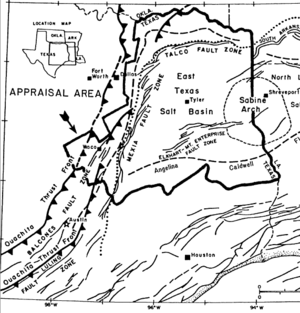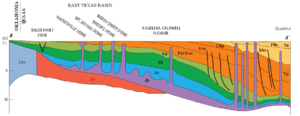East Texas Oil Field


The East Texas Oil Field is a large oil and gas field in east Texas. Covering 140,000 acres (570 km2) and parts of five counties, and having 30,340 historic and active oil wells, it is the second-largest oil field in the United States outside of Alaska, and first in total volume of oil recovered since its discovery in 1930.[1] Over 5.42 billion barrels of oil have been produced from it to-date.[2] It is a component of the Mid-Continent Oil Province, the huge region of petroleum deposits extending from Kansas to New Mexico to the Gulf of Mexico.
The field includes parts of Gregg, western Rusk, southern Upshur, southeastern Smith, and northeastern Cherokee counties in the northeastern part of the state. Overall the field is about 45 miles (72 km) long on the north-south axis, and five miles (8 km) across. Interstate 20 cuts across the field from east to west, and the towns of Kilgore, Overton, and Gladewater are on the field. At one time, downtown Kilgore had more than 1,000 active wells clustered in a tight area, making it the densest oil development in the world.[3]
Geology

The primary productive geologic unit is the Cretaceous-age Woodbine Formation, a regional petroleum-bearing unit which had been known since the early part of the 20th century. This sandstone unit was deposited during a period when East Texas was a shallow sea, approximately 100 million years ago. During a subsequent period it was uplifted, eroded, and then covered again by the sea, which this time deposited a layer of impermeable chalk, creating a stratigraphic trap – a situation where oil, which is lighter than water and migrates upwards, reaches a point where it can move no farther, and pools. The source rock for the oil in East Texas is the overlying Eagle Ford Shale.[4]
Water intrusion from deeper in Woodbine Formation is the mechanism pushing oil through the reservoir toward the producing wells. A 1932 study showed that oil wells stopped flowing when water pressure dropped below 800 pounds per square inch.[5]
More recently, the gas-rich Jurassic Haynesville Shale has become the target of exploration and production.[6]
History
Several early attempts were made to produce oil in the area, beginning in 1911, with the failed Millville Oil Company, but drilling technology had not progressed sufficiently to reach oil at the depths it is found there, which are mainly below 3,501 feet (1,067 m); most early wells ended in broken bits, dry holes, and bankrupt operators. Finally, an enterprising Alabama man, Columbus Marion (Dad) Joiner, was the first with enough persistence to succeed, and on October 3, 1930, his Daisy Bradford No. 3 well (named after the widow who owned the farm) hit oil at 3,536 feet (1,078 m) below ground surface.[7] The well is located near the southeastern boundary of the oil field.[8]
Shortly after the Daisy Bradford find and after another two smaller wells were drilled near the original hole, another new well, this one on the Crim family farm about nine miles (14 km) north of the Bradford farm, reached oil, producing a gusher with a spectacular initial daily flow of 22,000 barrels (3,500 m3). That the two wells were in a connected oil reservoir was not immediately obvious to those who drilled them, as no field this large had ever been discovered.[9] In January 1931, yet another group of investors and drillers put in a third important well about 25 miles (40 km) north of the initial Daisy Bradford well; it gushed 320 barrels (51 m3) of oil per hour, from approximately the same depth as the other two wells, 3,587 feet (1,093 m). Within a few months, drillers, landowners, and investors began to realize they had a spectacular oil field two thirds of a mile under their feet, one that would produce enormous quantities of high-grade oil almost anywhere they drilled.[3]
Haroldson Lafayette “H.L.” Hunt was among the independent oil producers who rushed to East Texas. Hunt had been successful during the 1920s in the El Dorado and Smackover oil fields of Arkansas. When Dad Joiner found himself in legal trouble soon after the Daisy Bradford No. 3 discovery, Hunt met with him at the Baker Hotel in Dallas in November 1930 and bought the well and 5,580 acres for $1.34 million. By the summer of 1931, about 1,200 Rusk County oil wells were producing 900,000 barrels of oil a day. Hunt's purchase provided the financial base for him to found Hunt Oil Company in 1934.[10]
It was the enormous quantities of oil from the East Texas Oil Field and their importance to the Allied effort in World War II that led to the creation of the world's largest pipeline until that time, the "Big Inch", a 24-inch (610 mm), 1,400-mile (2,300 km) pipeline which transported crude to refineries in the Philadelphia area. Prior to building the pipeline, oil had to be transported by ship, and many such ships were sunk by German submarines during the early part of the war, especially in 1942 and early 1943. Construction of the pipeline commenced in August 1942 and terminated on March 2, 1944. By the end of the war, over 350 million barrels (56,000,000 m3) of crude flowed from East Texas to the northeast states through the Big Inch.[11]
In the middle of the 20th century, the East Texas Oil Field was the center of a slant-hole scandal.[12] Some unscrupulous operators had drilled slanted holes from across their lease lines into the productive portions of the Woodbine formation. Inspectors found 380 deviated wells and shut them down with the assistance of the Texas Rangers.[13] An estimated $100 million worth of oil was stolen over several decades from legal owners.[3]
Today, the area remains a strong contributor to oil production in Texas. The significance of the region to Texas' overall production, however, has been tempered by the increase of drilling activity in the Eagle Ford shale and the Permian Basin Plays. [14]
Since its discovery, the East Texas Oil Field has produced more than 5.2 billion barrels (830,000,000 m3) of oil, and it originally contained more than 7 billion barrels (1.1×109 m3).[3][15]
See also
- List of oil pipelines
- List of oil refineries
- East Texas Oilfield Expo
- Burford v. Sun Oil Co.
References
- Norman J. Hyne: Nontechnical Guide to Petroleum Geology, Exploration, Drilling, and Production. PennWell Books, 2001. ISBN 0-87814-823-X
- East Texas Oil Field from the Handbook of Texas Online
- Gregg County's Oil Field
- American Oil and Natural Gas Historical Society
- Texas Oil and Gas Since 1543
- East Texas Oil Field Brochure
- East Texas Oil Museum online
- Yergin, Daniel (1992). The Prize: The Epic Quest for Oil, Money & Power.
References
- ↑ Smith, Julia Cauble. "EAST TEXAS OILFIELD". Handbook of Texas Online. Texas State Historical Association. Retrieved 4 February 2014.
- ↑ Dokur, M., and Hentz, T.F., (2012). Reservoir Characterization of the Upper Cretaceous Woodbine Group in Northeast Texas Field, Texas. AAPG Search and Discovery Article #20152.
- 1 2 3 4 "East Texas Oilfield," Handbook of Texas Online
- ↑ Hyne, p. 51-55.
- ↑ Interpretation of Bottom-Hole Pressures in East Texas Oil Field Archived February 11, 2012, at the Wayback Machine. (AAPG Bulletin, 1932)
- ↑ Roach, Eric. "The East Texas Bsin Continues to Surprise". DI Blog. drillinginfo. Retrieved 8 June 2017.
- ↑ Silvey, Lucille (2009). The History of the East Texas Oil Field Archived June 24, 2016, at the Wayback Machine.. Retrieved April 30, 2012.
- ↑ East Texas Oil Field Brochure (joint production of several area Chambers of Commerce)
- ↑ East Texas Oil Museum online
- ↑ Wells, Bruce. "H.L. Hunt and the East Texas Oilfield". American Oil & Gas Historical Society. Retrieved 13 November 2014.
- ↑ "Big Inch and Little Big Inch", Handbook of Texas Online
- ↑ SLANT-WELL INQUIRY RESUMES IN DALLAS, "New York Times", September 11, 1962" (Accessed 31 March 2009)
- ↑ Drilling on the Slant, "Texas Ranger Dispatch Magazine" Archived June 24, 2016, at the Wayback Machine. (Accessed 30 June 2011)
- ↑ "Texas Drilling Permits". Well Activity.
- ↑ Hyne, p. 52
Coordinates: 32°23′8″N 94°52′7″W / 32.38556°N 94.86861°W